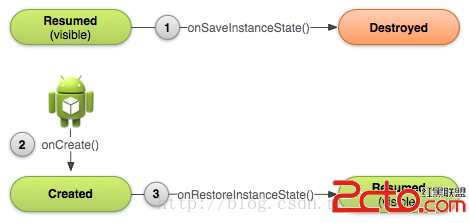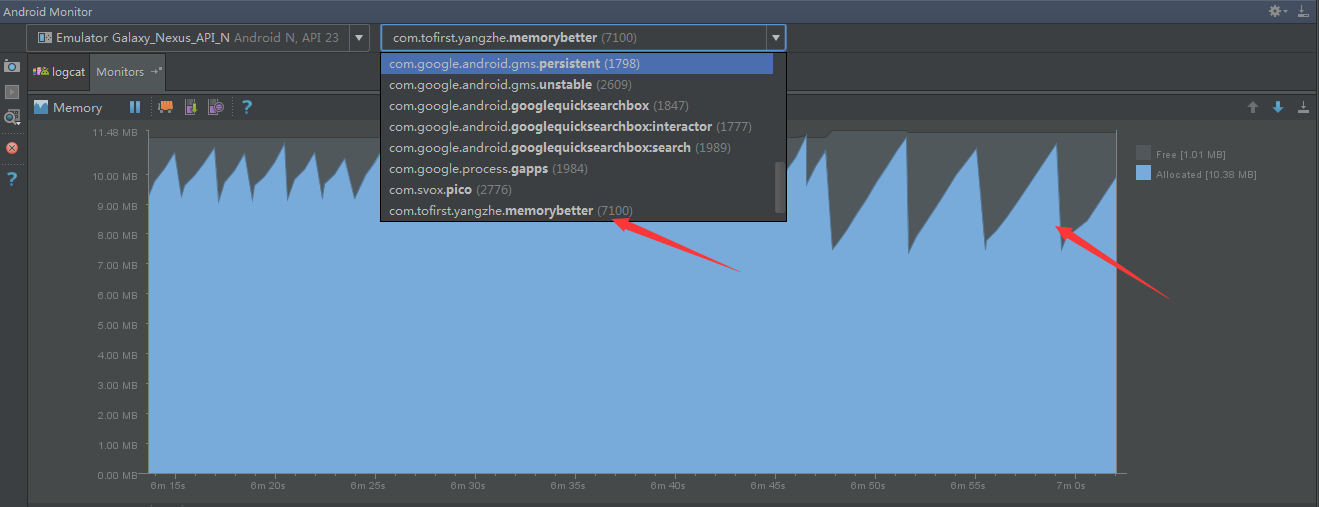編輯:關於Android編程
先占個位置,下次翻譯~ :p
There are a few scenarios in which your activity is destroyed due to normal app behavior, such as when the user presses the Back button or your activity signals its own destruction by calling finish().
The system may also destroy your activity if it's currently stopped and hasn't been used in a long time or the foreground activity requires more resources so the system must shut down background processes to recover memory.
When your activity is destroyed because the user presses Back or the activity finishes itself, the system's concept of that Activity instance
is gone forever because the behavior indicates the activity is no longer needed. However, if the system destroys the activity due to system constraints (rather than normal app behavior), then although the actual Activity instance
is gone, the system remembers that it existed such that if the user navigates back to it, the system creates a new instance of the activity using a set of saved data that describes the state of the activity when it was destroyed. The saved data that the system
uses to restore the previous state is called the "instance state" and is a collection of key-value pairs stored in a Bundle object.
Caution: Your activity will be destroyed and recreated each time the user rotates the screen. When the screen changes orientation, the system destroys and recreates the foreground activity because the screen configuration has changed and your activity might need to load alternative resources (such as the layout).
By default, the system uses the Bundle instance
state to save information about each View object
in your activity layout (such as the text value entered into an EditText object).
So, if your activity instance is destroyed and recreated, the state of the layout is restored to its previous state with no code required by you. However, your activity might have more state information that you'd like to restore, such as member variables
that track the user's progress in the activity.
Note: In order for the Android system to restore the state of the views in your activity, each view must have a unique ID, supplied by the android:id attribute.
To save additional data about the activity state, you must override the onSaveInstanceState() callback
method. The system calls this method when the user is leaving your activity and passes it the Bundle object
that will be saved in the event that your activity is destroyed unexpectedly. If the system must recreate the activity instance later, it passes the same Bundle object
to both the onRestoreInstanceState() and onCreate() methods.

Figure 2. As the system begins to stop your activity, it calls onSaveInstanceState() (1)
so you can specify additional state data you'd like to save in case the Activity instance
must be recreated. If the activity is destroyed and the same instance must be recreated, the system passes the state data defined at (1) to both the onCreate() method
(2) and theonRestoreInstanceState() method
(3).
As your activity begins to stop, the system calls onSaveInstanceState() so
your activity can save state information with a collection of key-value pairs. The default implementation of this method saves information about the state of the activity's view hierarchy, such as the text in an EditText widget
or the scroll position of aListView.
To save additional state information for your activity, you must implement onSaveInstanceState() and
add key-value pairs to the Bundle object.
For example:
static final String STATE_SCORE = "playerScore";
static final String STATE_LEVEL = "playerLevel";
...
@Override
public void onSaveInstanceState(Bundle savedInstanceState) {
// Save the user's current game state
savedInstanceState.putInt(STATE_SCORE, mCurrentScore);
savedInstanceState.putInt(STATE_LEVEL, mCurrentLevel);
// Always call the superclass so it can save the view hierarchy state
super.onSaveInstanceState(savedInstanceState);
}
Caution: Always call the superclass implementation of onSaveInstanceState() so
the default implementation can save the state of the view hierarchy.
When your activity is recreated after it was previously destroyed, you can recover your saved state from theBundle that
the system passes your activity. Both the onCreate() and onRestoreInstanceState() callback
methods receive the same Bundle that
contains the instance state information.
Because the onCreate() method
is called whether the system is creating a new instance of your activity or recreating a previous one, you must check whether the state Bundle is
null before you attempt to read it. If it is null, then the system is creating a new instance of the activity, instead of restoring a previous one that was destroyed.
For example, here's how you can restore some state data in onCreate():
@Override
protected void onCreate(Bundle savedInstanceState) {
super.onCreate(savedInstanceState); // Always call the superclass first
// Check whether we're recreating a previously destroyed instance
if (savedInstanceState != null) {
// Restore value of members from saved state
mCurrentScore = savedInstanceState.getInt(STATE_SCORE);
mCurrentLevel = savedInstanceState.getInt(STATE_LEVEL);
} else {
// Probably initialize members with default values for a new instance
}
...
}
Instead of restoring the state during onCreate() you
may choose to implement onRestoreInstanceState(),
which the system calls after the onStart() method.
The system calls onRestoreInstanceState() only
if there is a saved state to restore, so you do not need to check whether the Bundle is
null:
public void onRestoreInstanceState(Bundle savedInstanceState) {
// Always call the superclass so it can restore the view hierarchy
super.onRestoreInstanceState(savedInstanceState);
// Restore state members from saved instance
mCurrentScore = savedInstanceState.getInt(STATE_SCORE);
mCurrentLevel = savedInstanceState.getInt(STATE_LEVEL);
}
Caution: Always call the superclass implementation of onRestoreInstanceState() so
the default implementation can restore the state of the view hierarchy.
To learn more about recreating your activity due to a restart event at runtime (such as when the screen rotates), read Handling Runtime Changes.
 android NFC開發案例+MifareClassic格式密碼修改(鍵值keyA修改)
android NFC開發案例+MifareClassic格式密碼修改(鍵值keyA修改)
在開始之前可以先了解一些NFC的的基礎知識。 感謝Eternal_memory 和 SkySeraph部分解析BaseMethodWebActivity是Act
 Android XML數據的三種解析方式
Android XML數據的三種解析方式
本篇文章包含以下內容: XML數據的Dom解析 XML數據的Sax解析&n
 android控件之間事件傳遞
android控件之間事件傳遞
public boolean dispatchTouchEvent(MotionEvent ev){} 用於事件的分發,Android中所有的事件都必須經
 Android Studido下的應用性能優化總結-內存優化
Android Studido下的應用性能優化總結-內存優化
上一篇文章總結的布局優化的問題,如果對布局優化不是很熟悉的,可以看一下Android Studido下的應用性能優化總結–布局優化 , 這周一直籌劃總結一下內